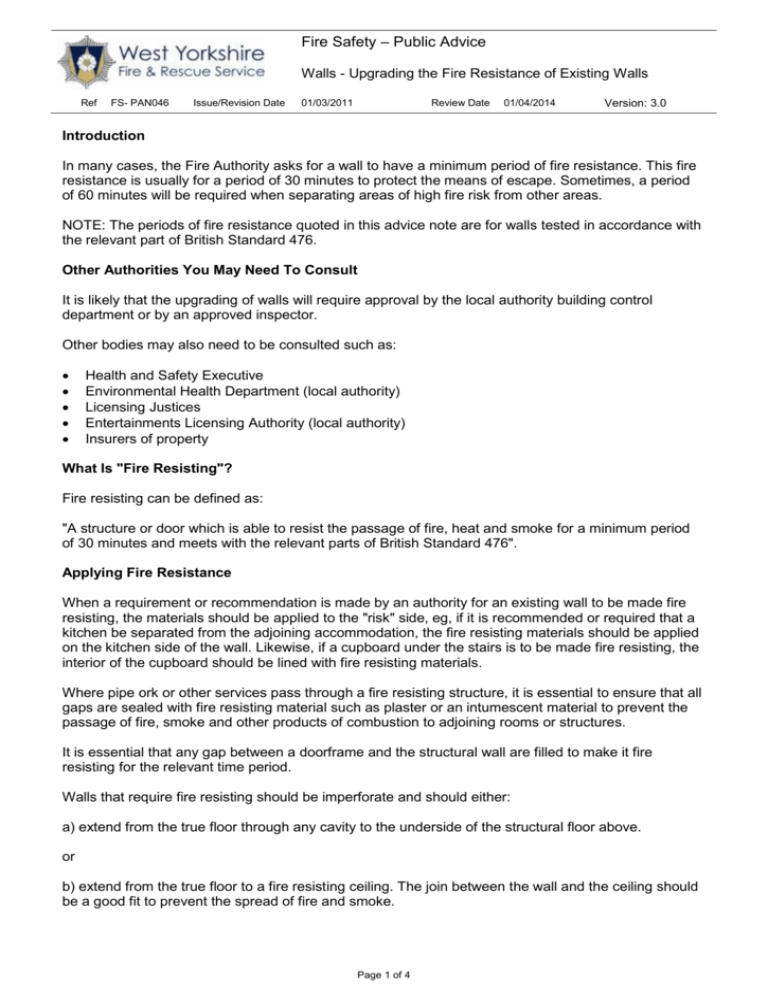Upgrading the Fire Resistance of Existing Walls
advertisement

Fire Safety – Public Advice Walls - Upgrading the Fire Resistance of Existing Walls Ref FS- PAN046 Issue/Revision Date 01/03/2011 Review Date 01/04/2014 Version: 3.0 Introduction In many cases, the Fire Authority asks for a wall to have a minimum period of fire resistance. This fire resistance is usually for a period of 30 minutes to protect the means of escape. Sometimes, a period of 60 minutes will be required when separating areas of high fire risk from other areas. NOTE: The periods of fire resistance quoted in this advice note are for walls tested in accordance with the relevant part of British Standard 476. Other Authorities You May Need To Consult It is likely that the upgrading of walls will require approval by the local authority building control department or by an approved inspector. Other bodies may also need to be consulted such as: Health and Safety Executive Environmental Health Department (local authority) Licensing Justices Entertainments Licensing Authority (local authority) Insurers of property What Is "Fire Resisting"? Fire resisting can be defined as: "A structure or door which is able to resist the passage of fire, heat and smoke for a minimum period of 30 minutes and meets with the relevant parts of British Standard 476". Applying Fire Resistance When a requirement or recommendation is made by an authority for an existing wall to be made fire resisting, the materials should be applied to the "risk" side, eg, if it is recommended or required that a kitchen be separated from the adjoining accommodation, the fire resisting materials should be applied on the kitchen side of the wall. Likewise, if a cupboard under the stairs is to be made fire resisting, the interior of the cupboard should be lined with fire resisting materials. Where pipe ork or other services pass through a fire resisting structure, it is essential to ensure that all gaps are sealed with fire resisting material such as plaster or an intumescent material to prevent the passage of fire, smoke and other products of combustion to adjoining rooms or structures. It is essential that any gap between a doorframe and the structural wall are filled to make it fire resisting for the relevant time period. Walls that require fire resisting should be imperforate and should either: a) extend from the true floor through any cavity to the underside of the structural floor above. or b) extend from the true floor to a fire resisting ceiling. The join between the wall and the ceiling should be a good fit to prevent the spread of fire and smoke. Page 1 of 4 For the construction of the wall suitable materials would be brick, blockwork or studwork partitioning with a 12.5mm thickness of Portland Cement Plaster or Gypsum Plaster on each face of the studwork with joints taped, filled and timber backed. The studwork should not be less than 76mm x 50mm (3" x 2"). Any door in a fire resisting wall should comprise of a fire resisting doorset, ie, door and frame tested in accordance with BS 476: Part 22 and or 31.1 if a smoke seal door is also required. Fire Resisting Glazing Glazed elements in fire resisting walls should be of fire resisting wired cast glass or other fire resisting glass. Where insulation against radiated heat is required, a type of fire resisting glass, which affords such insulation should be specified. There are various ways of fixing fire resisting glass into its frame. For example, in a wooden frame the glass should be fixed with hardwood beads of specified dimensions, chamfered and fixed to the frame with steel woodscrews. An intumescent bead is fitted between each side of the glass and the bead or frame. There are also various metal frame systems available. It is essential that the glass manufacturer's instructions are carefully followed in order that the finished glazing system will achieve the minimum period of fire resistance that is sought. Surface Spread Of Flame Category The finished fire resisting wall should have a low surface spread of flame rating, at least no higher than that required by the relevant authority. Class O is the safest category. Lightweight Demountable Partitioning If lightweight demountable partitioning is used, the manufacturer's instructions should be carefully followed to ensure that the heights or lengths of partitioning do not exceed the dimensions covered by fire resisting test evidence. General The above methods are given as examples of effective ways of achieving an acceptable level of fire resistance. There are many other ways of achieving a similar standard of fire resistance, which can be obtained from the documents listed in the Bibliography below. Page 2 of 4 Bibliography TITLE From Building Regulations 1991 Approved Document B SO BS 476: Part 20: 1987 AMD 1 Fire tests on building materials and structures. Part 20: Method for determination of the fire resistance of elements of construction (general principles) (AMD 6487) dated 30 April 1990 BSI BS 476: Part 21: Methods for Determination of the Fire Resistance of Load Bearing Elements of Construction BSI BS 476: Part 22: Methods for Determination of the Fire Resistance of Non-Load Bearing Elements of Construction BSI BS 5588: Part 1: Code of Practice for Residential Buildings BSI BS 5588: Part 5: Code of Practice for Fire Fighting Staircases and Lifts BSI BS 5588-11: 1997 Fire precautions in the design, construction and use of buildings. Part 11: Code of practice for shops, offices, industrial storage and other similar buildings BSI PD 6512: Part 3: Guide to the Performance of Glass BSI Code of Practice for Fire Precautions in Factories, Offices, Shops and Railways Premises not required to have a Fire Certificate SO Guide to Fire Precautions in Existing Places of Work that require a Fire Certificate SO Guide to Fire Precautions in Existing Places of Entertainment and Like Premises SO The above publications are current at the time of preparation of this Advice Leaflet. Publications can be obtained from the following addresses: SO The Stationery Office Ltd PO BOX 29 Norwich, NR3 1GN Or Blackwells 21 Blenheim Terrace Leeds, LS2 9HJ BSI British Standards Institution (Sales) 389 Chiswick High Road LONDON W44 AR BRE Building Research Establishment Garston, Watford, WD25 9XX TRADA Technology Ltd Stocking Lane TRADA Hughendon Valley High Wycombe Bucks, HP14 4ND Tel: 0870 600 5522 Fax: 0870 600 5533 e-mail: customer.services@tso.co.uk web: www.tso.co.uk/bookshop/bookstore.asp Tel: 0113 245 2623 Fax: 0113 242 5641 E-mail:osleeds@blackwellsbookshops.co.uk Tel: 0208 996 7003 e-mail: cservices@bsi-global.com web: bsonline.techindex.co.uk/ Tel: 01923 894040 e-mail: enquiries@bre.co.uk web: www.bre.co.uk Tel: 01494 569600 Fax: 01494 565487 e-mail: information@trada.co.uk web: www.trada.co.uk Page 3 of 4 Further Advice Further advice on achieving fire resisting standards may be obtained from: The Timber Research and Development Association (address given in the Bibliography) Your local fire station The local authority building control office at the address given below; BRADFORD Building Control Services 3rd Floor Jacob's Well Nelson Street Bradford, BD1 5RW Calderdale Building Control Services CALDERDALE Westgate House Westgate Halifax, HX1 1PS Tel: 01274 433807 Fax: 01274 435801 Web: http://www.bradford.gov.uk Tel: 01422 392223 (Answerphone service when closed). Fax: 01422 392203 Email: building.control@calderdale.gov.uk KIRKLEES Building Control Department Kirklees Metropolitan Council Property Services PO Box B95 Civic Centre HUDDERSFIELD, HD1 2NA Tel: 01484 422133 Email: building.control@kirklees.gov.uk Web: http://www.kirklees.gov.uk/ LEEDS Development Enquiry Centre Leonardo Building, 2 Rossington Street Leeds, LS2 8HD Tel: 0113 247 8000 Email: PLAN.Building.Control@leeds.gov.uk Web: http://www.leeds.gov.uk WAKEFIELD Building Control Services Newton Bar, Leeds Road, Wakefield WF1 2TX Tel: 01924 306580 e-mail: buildingcontrol@wakefield.gov.uk Web: http://www.wakefield.gov.uk Other related Public Advice Notes FS-PAN023 - Doors - general FS-PAN025 - Doors - upgrading the fire resistance of existing doors FS-PAN032 - Fire resistance - general standards Page 4 of 4







